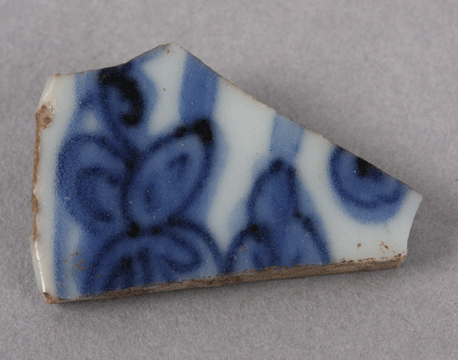

Ming dynasty porcelain fragment, San Gabriel de Yunque (MMA 68.43.64)
During Asian and Pacific American Heritage Month, we feature objects from Asia and the Pacific in the Maxwell's collections.
This late Ming dynasty (AD1368-1644) blue-and-white porcelain sherd is a fragment of a vessel that made a long journey to New Mexico, where it is currently held in the Maxwell Museum of Anthropology collections. The small rim sherd was recovered in the 1960s in UNM field school excavations at the site of San Gabriel de Yunque-Ouinge. Located at the confluence of the Rio Grande and Chama River, San Gabriel de Yunque-Ouinge was established at Yunque Pueblo as the first Spanish colonial capital in New Mexico, a role it served from AD 1598 to 1610.
The bowl began its story in southern China, where it was created in a late 16th pottery workshop. It was acquired, one in a load of hundreds or thousands of similar ceramics, by Fujian merchants and loaded onto a Chinese ship heading to the Spanish colonial capital of Manila in the Philippines. From there, it was transferred to a Spanish galleon destined for the Americas. A major source of wealth for the Spanish Empire, the Manila Galleon trade (AD 1565-1815) brought Asian goods to the Americas and on return trips the galleons carried vast quantities of silver and other goods extracted by the Spanish from indigenous peoples back to the Philippines. Rather than continue its travels from Mexico to Spain, as many Asian commodities brought by the Manilla Galleon did, this small bowl was instead carried overland to San Gabriel de Yunque-Ouinge where it likely ornamented the table of a colonial officer or priest.
Chinese kilns produced hundreds of thousands of ceramic serving and storage vessels throughout the late first and second millennias AD. Long-established trade networks carried ceramics and other commodities throughout Asia, Africa, and Europe for centuries before the establishment of the Manila Galleon. This one-inch long porcelain fragment provides a glimpse into a world of interactions connecting Asia, Europe and the Americas through colonization and commerce by the early 1600s.